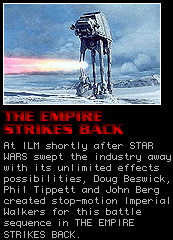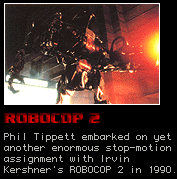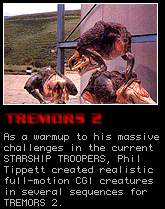Spotlight : May 1997
The Morphing Artist: From Stop-Motion to
CGI
By Scott Essman
Spotlight : May 1997
The Morphing Artist: From Stop-Motion to
CGI
By Scott Essman
When George Lucas asked Rick Baker to create additional
creatures for the famed cantina sequence in STAR WARS, few
realized that the collection of artists that Baker recruited would
become a "who's who" of modern special effects masters. In
addition to Baker himself, who worked on several cantina creatures
but was not present during shooting due to his commitments on THE
INCREDIBLE MELTING MAN, the young team included Jon Berg, Doug
Beswick, Rob Bottin, Laine Liska, and Phil Tippett. This tightly
-knit group, many of whom were stop-motion animators, and others
from the STAR WARS effects crew, went on to revolutionize the course
of special creature effects in many of the landmark effects-oriented
films of the past 20 years, leading the way to computer graphic
imaging (CGI) and digital effects.
A sizable portion of STAR WARS' special effects crew had worked
together at fledgling production houses in Southern California during
the late 1960s and early 1970s. Berg and Tippett had paid their dues
at Cascade Pictures where they worked on TV commercials creating
stop-motion animation with other luminaries including David Allen
(who created new KING KONG animation for "Special Effects," a 1996
IMAX film), and future ILM visual effects impresario Dennis Muren.
Meanwhile, Baker, Beswick, and future GREMLINS animator Peter
Kleinow worked at cross-county Clokey Productions, where they
animated "Gumby" and "Davy and Goliath." As Beswick remembers:
"We were like a clique; we would all go to the beach or to a barbecue
on weekends." Baker remembers them being "young enthusiastic guys,
thinking 'someday maybe we can work on a real movie together.'"
Shortly thereafter, Baker and Beswick created an amateur Neanderthal
film and were hired to create the suit for the low-budget feature
OCTAMAN. In the mid-1970s, Baker developed an unprecedented level
of realistic primate work in John Landis' SCHLOCK and KENTUCKY FRIED
MOVIE, and in the remake of KING KONG, before George Lucas called him
in 1976.
The team for STAR WARS was recruited quickly and easily. Baker
brought his team together from his old Clokey and Cascade peers, Liska
among them, plus a young apprentice he had acquired named Rob Bottin.
Originally, renowned creature designer Stuart Freeborn (2001: A SPACE
ODYSSEY) had created characters that were shot in England for the scene,
but Lucas felt more were required to give the cantina proper alien
ambience. Hence, many of the noted creatures in the scene were shot
as live-action inserts on a duplicate set in California in one day. By
then, another Cascade staple, Dennis Muren, had joined the STAR WARS
crew as well. He worked on John Dykstra's visual effects team with
future Boss Films-founder Richard Edlund and a young mechanical
equipment designer named Stuart Ziff.
In 1981, a breakthrough arrived when Ziff, working with
Tippett at ILM, created the Go-Motion Figure Mover, a device that
allowed Tippett's animation to move more fluidly in DRAGONSLAYER.
According to Ziff, "the machine eliminated the strobing and jitter
which [had previously characterized] stop motion animation."
The two again collaborated on the creature work in Jabba's
palace for RETURN OF THE JEDI. 400 miles from the Northern
California locale of ILM, Richard Edlund had formed Boss Films
after JEDI to create the effects for GHOSTBUSTERS. He hired Ziff
to head the "ghost shop" where he supervised a wealth of new
creature designers, including animator Randall William Cook who
created the stop-motion Terror Dogs. Tippett, still at ILM, created
stop-motion creatures for Lucas "Ewok" TV movies and shot a
stop-motion dinosaur film entitled "Prehistoric Beast" in his home
garage. This project that would forecast a new wave of creature
animation for the industry a decade later.
As the 1980s ended, at ILM, Dennis Muren's groundbreaking
CGI water tentacle in Cameron's THE ABYSS was a portent of things to
come. Most notably, Cameron's T2: JUDGEMENT DAY expanded on the
concept of computer animation and changed the face of cinema
thereafter. But one more project would vault CGI into the
limelight even more exponentially than T2. Based on his lasting
interest in animating dinosaurs, Tippett created test stop-motion
footage for JURASSIC PARK, detailed treatments of the kitchen
sequence with the velociraptors and the attack sequence with the
Tyrannosaurus Rex. His work was comprised of stop-motion reference
puppetry mixed with storyboards and resembled the animation in
"Prehistoric Beast." After Steven Spielberg saw the footage, he
inked Tippett to create stop-motion dinosaur animations to match
Stan Winston's live-action mechanical beasts. Then Muren and ILM
developed CGI dinosaur tests (originally meant for only a few
shots) that were so convincing, it was obvious that they would
eliminate the need for any stop-motion work.
The impact of JURASSIC PARK decidedly influenced other stop-
motion animators. Doug Beswick, with partners Kevin O'Neill and Kevin Kutchaver, set
up Flat Earth, a production
company dedicated to computer animation. At his new Burbank
facility, Beswick, O'Neill, and Kutchaver supervise a team of six who build models,
render them, and perform 2-D and 3-D computer animation for TV
shows such as "Hercules" and "Xena." Richard Edlund's Boss Films
still makes use of motion-control camera equipment similar to that
used on STAR WARS, but much of his Marina Del Ray studio is given
to digital computer effects for recent films such as MULTIPLICITY.
The success of CGI in JURASSIC PARK was certainly not lost on Phil
Tippett himself. Not one to become "extinct," Tippett has
acquired an additional building for his Berkeley complex, housing
over 100 workstations for the 80+ computer animators he has hired
for the current STARSHIP TROOPERS.
With major CGI releases this year including Tippett's TROOPERS,
THE LOST WORLD (with Muren still at ILM after 20 years),
and Cameron's TITANIC, for which a myriad of digital effects shots
will be required, the level of computer animation is certain
to reach new heights. Twenty years after STAR WARS release, even
Rick Baker is utilizing CGI to complete "makeup tests" on actors
without the need to make molds and produce foam latex. As for
George Lucas, one cannot help but expect outstanding CGI material
for the STAR WARS prequels which begin shooting this year. Still,
the possibility lingers for a new version of KING KONG which would
likely feature David Allen's stop-motion animation of Kong, which may
merely serve as an homage at this technological point in time.
 The wild success of STAR WARS simultaneously created
both a
new demand for effects and an industry to support it. Lucas
immediately began production on THE EMPIRE STRIKES BACK, which
included one of the most stirring stop-motion sequences of the
era: the Imperial Walker battle on the ice planet, Hoth. Tippett,
Berg and Beswick, all ILM fixtures, created the animation under
the visual effects supervision of Muren and Edlund, who again
enlisted Ziff, this time to manufacture the optical printer that
coordinated the compositing of stop-motion and live-action
elements. During the same period, Bottin became the most
acclaimed young creature designer in the field with films like THE
HOWLING, THE THING, and LEGEND, giving Baker stiff competition
despite his own makeup successes in AMERICAN WEREWOLF IN LONDON
and GREYSTOKE.
The wild success of STAR WARS simultaneously created
both a
new demand for effects and an industry to support it. Lucas
immediately began production on THE EMPIRE STRIKES BACK, which
included one of the most stirring stop-motion sequences of the
era: the Imperial Walker battle on the ice planet, Hoth. Tippett,
Berg and Beswick, all ILM fixtures, created the animation under
the visual effects supervision of Muren and Edlund, who again
enlisted Ziff, this time to manufacture the optical printer that
coordinated the compositing of stop-motion and live-action
elements. During the same period, Bottin became the most
acclaimed young creature designer in the field with films like THE
HOWLING, THE THING, and LEGEND, giving Baker stiff competition
despite his own makeup successes in AMERICAN WEREWOLF IN LONDON
and GREYSTOKE.
 Beswick and Tippett brought stop-motion to a new level on
several projects in the mid-1980s. James Cameron brought in
Beswick for two successive projects: THE TERMINATOR and ALIENS.
Beswick had to match his Terminator "endoskeleton" designs and
ALIENS' "power loader" character movement to those of full-sized
beings created by makeup/character artist Stan Winston. Having
formed Tippett Studio in the wake of independent assignments,
Tippett developed the stop-motion ED-209 for Paul Verhoeven's
ROBOCOP and the multi-faceted "Robocop 2" for the sequel, again
collaborating with STAR WARS cantina designer Rob Bottin. At this
time, Beswick built and stop-motion animated the Bat-Gremlin from designs by Rick
Baker for Joe Dante's sequel, GREMLINS 2,
and Stuart Ziff sided with Bottin, creating mechanics for Bottin's
robotic designs in Verhoeven's TOTAL RECALL.
Beswick and Tippett brought stop-motion to a new level on
several projects in the mid-1980s. James Cameron brought in
Beswick for two successive projects: THE TERMINATOR and ALIENS.
Beswick had to match his Terminator "endoskeleton" designs and
ALIENS' "power loader" character movement to those of full-sized
beings created by makeup/character artist Stan Winston. Having
formed Tippett Studio in the wake of independent assignments,
Tippett developed the stop-motion ED-209 for Paul Verhoeven's
ROBOCOP and the multi-faceted "Robocop 2" for the sequel, again
collaborating with STAR WARS cantina designer Rob Bottin. At this
time, Beswick built and stop-motion animated the Bat-Gremlin from designs by Rick
Baker for Joe Dante's sequel, GREMLINS 2,
and Stuart Ziff sided with Bottin, creating mechanics for Bottin's
robotic designs in Verhoeven's TOTAL RECALL.
 Tippett felt as if he were becoming "extinct," but Spielberg
was attached enough to Tippett's work to retain him as "dinosaur
supervisor." In fact, Tippett's original animation in the two stop-
motion test sequences was utilized by ILM's computer animators, in
many cases identically. To achieve this, Stuart Ziff was again
brought on board, in this instance to create a "dinosaur input
device" (or DID). Ziff explains that "63 encoders were wired on
each of two 2.5-foot-long DID puppets to input the position of the
puppet's joints in a computer. The positions were then used to
animate the computer-generated dinosaurs in the film." The
collaboration between Ziff, Tippett and Muren's team at ILM
produced the most memorable material in the finished film.
Tippett felt as if he were becoming "extinct," but Spielberg
was attached enough to Tippett's work to retain him as "dinosaur
supervisor." In fact, Tippett's original animation in the two stop-
motion test sequences was utilized by ILM's computer animators, in
many cases identically. To achieve this, Stuart Ziff was again
brought on board, in this instance to create a "dinosaur input
device" (or DID). Ziff explains that "63 encoders were wired on
each of two 2.5-foot-long DID puppets to input the position of the
puppet's joints in a computer. The positions were then used to
animate the computer-generated dinosaurs in the film." The
collaboration between Ziff, Tippett and Muren's team at ILM
produced the most memorable material in the finished film.
 Proving his competency with
full-motion creatures in TREMORS 2, Tippett is going all-out for
what promises to be the next level of CGI capabilities. Where
JURASSIC PARK featured some 50 CGI shots, TROOPERS will require
nearly 200 CGI shots. Nevertheless, Tippett predicts he will someday
complete his stop-motion swan song when the time and situation are
appropriate.
Proving his competency with
full-motion creatures in TREMORS 2, Tippett is going all-out for
what promises to be the next level of CGI capabilities. Where
JURASSIC PARK featured some 50 CGI shots, TROOPERS will require
nearly 200 CGI shots. Nevertheless, Tippett predicts he will someday
complete his stop-motion swan song when the time and situation are
appropriate.
| SCOTT ESSMAN (sessman@ibm.mtsac.edu) is the author of "Creature People," an upcoming book, video and CD-ROM project about special makeup effects artists. He wrote career retrospective articles about Michael Westmore for Cinefex #68 and about John Chambers for upcoming Cinefex #71. Scott has also written and directed a documentary about a creature-oriented film, "Making Wolvy." |
Back to the Spotlight Main Menu

. . VFX HQ Produced by Todd Vaziri . . http://www.vfxhq.com . . e-mail: tvaziri@gmail.com . .
All text Copyright © 1998 Todd Vaziri, unless otherwise noted